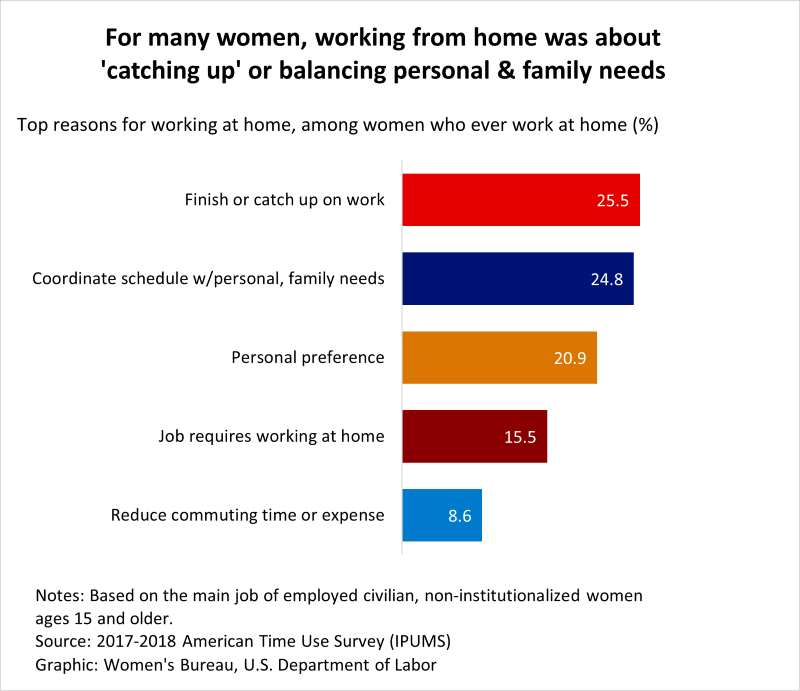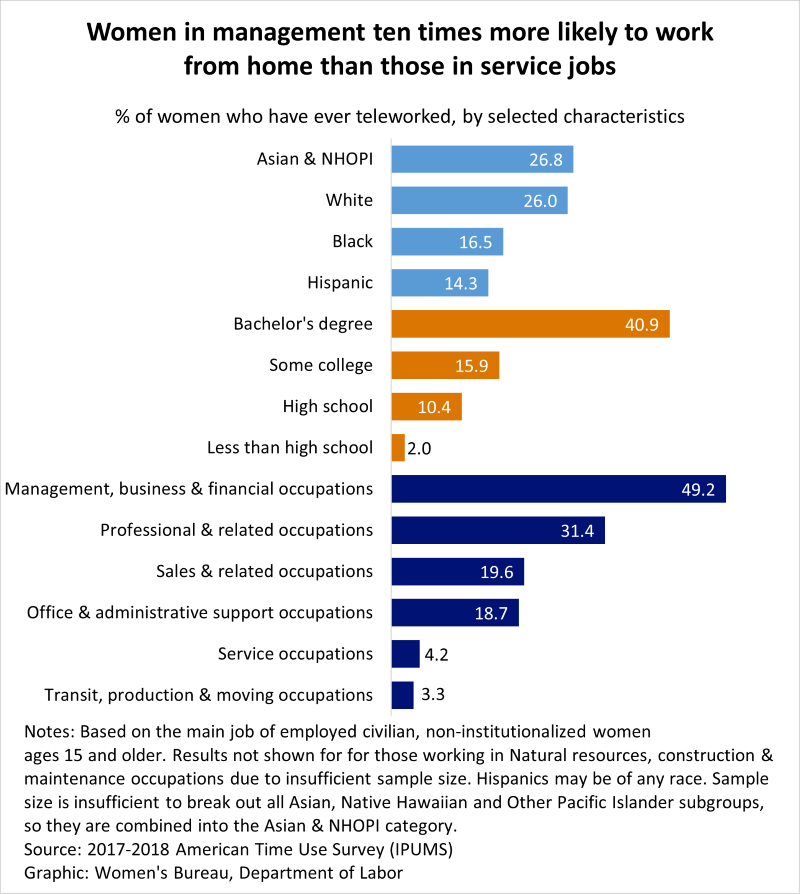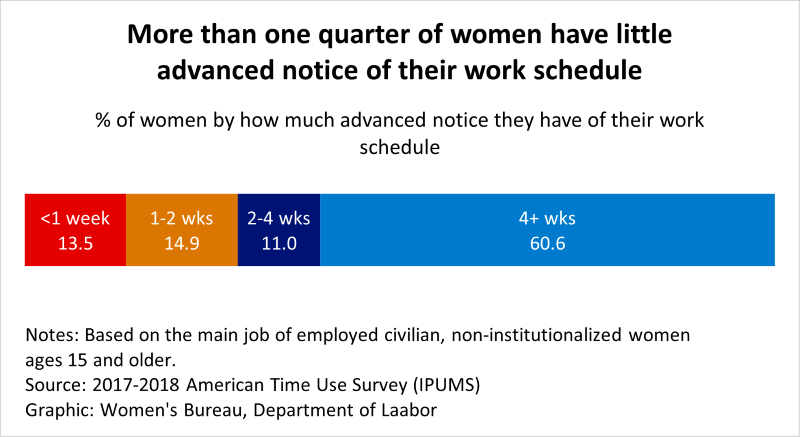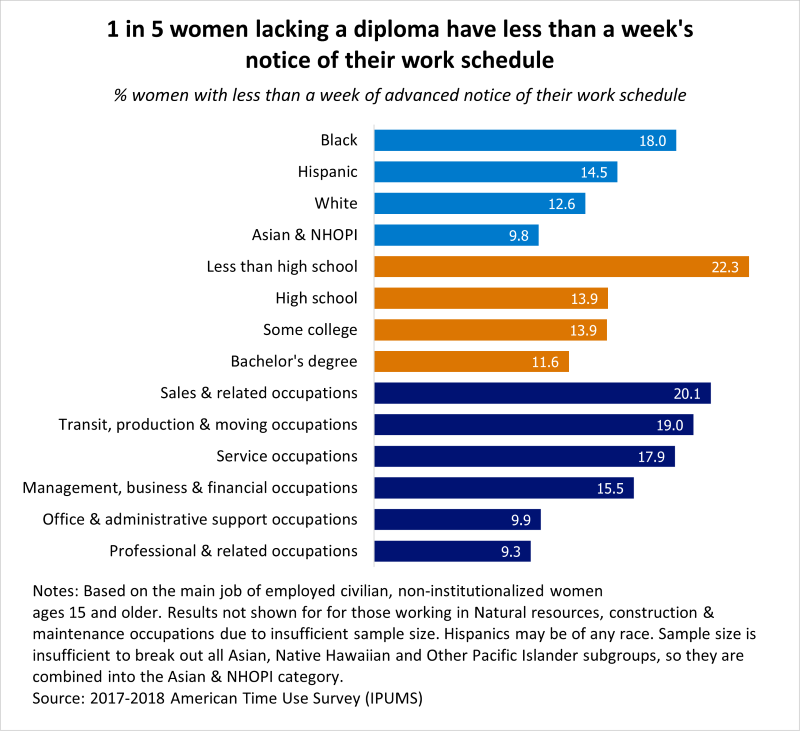COVID-19 upended traditional work protocols in terms of when and where women worked. The dramatic adjustment to remote work since 2020 has highlighted that it’s possible to offer greater flexibility in work arrangements, that such job qualities can help people manage personal and work responsibilities, and that access to such policies varies widely.
Even before the pandemic, there were ‘haves’ and ‘have nots’ in the workplace. Not just in terms of wage inequality, but also in terms of access to family-friendly jobs that allowed workers to accommodate their personal needs. The ability of people to telework and to know their schedule ahead of time are not always indicators of a more flexible workplace, but findings here show that these offerings help many workers juggle their responsibilities. While some workers had the freedom to take advantage of these policies, many – especially women of color and those with less education – did not.
Working from Home
About 1 in 4 women ever worked from home, but many were not paid for that work - plain text
Before the pandemic, 24% of women reported ever working from home for their main job, according to the 2017-2018 American Time Use Survey Leave Module, a nationally-representative survey administered by the Bureau of Labor Statistics and sponsored by the Women’s Bureau.

For some, working from home may offer the additional flexibility needed to navigate professional and personal responsibilities. In fact, 25% of female survey respondents who worked from home said they did so to coordinate with personal or family needs; and 66% of women who worked from home said they always got paid for that work.
It’s important to keep in mind, though, that in some cases, people may work at home because their professional duties spill over into their personal time. For instance, 25.5% of women who worked from home reported that the main reason they did so was to finish or catch up on work, and a similar share (22%) reported never getting paid for that work. Salaried workers were particularly likely to report as much.

The shares of women who ever worked from home varied markedly across groups. Fewer than 1 in 10 of those with less than a high school diploma (2.0%) or who worked in service (4.2%) or transit, materials moving and production (3.3%) ever worked at home. At the other end of the spectrum, 49.2% of women who worked in management, business or finance and 40.9% of those with a bachelor’s degree worked at home at least sometimes.
Advanced scheduling

More than one quarter of women have little advanced notice of their work schedule – plain text
Having advanced notice of one’s work schedule can help to accommodate personal demands such as caregiving, medical appointments or errands. Conversely, having to deal with just-in-time scheduling can wreak havoc on efforts to juggle the needs of work and family.

1 in 5 women lacking a diploma have less than a week's notice of their work schedule – plain text
More than one-quarter received less than two week’s notice, including 13.5% who found out their work schedule less than one week in advance.
About one-fifth of women with less than a high school diploma; those working in sales and those working in transit learned their schedule less than one week in advance. Meanwhile, Asian and other Pacific Islander women and women with office and administrative or professional occupations were far less likely to find out their work schedules at the last minute.
Conclusions
If there is one thing that the pandemic has highlighted, it’s that family-friendly work policies are essential for all workers. The unequal distribution of family-friendly policies – which is likely correlated with disparities in wages, leave and other benefits – creates yet another dimension of work inequality. While working from home or learning your work schedule ahead of time are not panaceas, they are all policies that may help some employees better manage their obligations. The U.S. needs to maintain and expand access to policies such as these, and to assure that these benefits accrue not only to the pre-existing "haves," but across the board, so that this dimension of labor market inequality can no longer exacerbate other forms of inequity.
Gretchen Livingston is a survey statistician in the department’s Women’s Bureau. Follow the bureau on Twitter at @WB_DOL.
About 1 in 4 women ever worked from home, but many were not paid for that work - plain text
| % of women who ever worked from home, and whether they were paid for that work | |
| Ever teleworked | 75.5 |
| Never teleworked | 24.5 |
| Of those who ever teleworked, the share who were paid for telework: | |
| Never | 22.2 |
| Sometimes | 11.6 |
| Always | 66.2 |
| Notes: Based on the main job of employed civilian, non-institutionalized women ages 15 and older. | |
| Source: 2017-2018 American Time Use Survey (IPUMS) | |
| Graphic: Women's Bureau, U.S. Department of Labor | |
| Top reasons for working at home, among women who ever work at home (%) | |
| Finish or catch up on work | 25.5 |
| Coordinate schedule w/personal, family needs | 24.8 |
| Personal preference | 20.9 |
| Job requires working at home | 15.5 |
| Reduce commuting time or expense | 8.6 |
| Notes: Based on the main job of employed civilian, non-institutionalized women ages 15 and older. | |
| Source: 2017-2018 American Time Use Survey (IPUMS) | |
| Graphic: Women's Bureau, U.S. Department of Labor | |
| % of women who have ever teleworked, by selected characteristics | |
| Management, business & financial occupations | 49.2 |
| Bachelor's degree | 40.9 |
| Professional & related occupations | 31.4 |
| Mother | 28.4 |
| Asian & NHOPI | 26.8 |
| White | 26.0 |
| Sales & related occupations | 19.6 |
| Office & administrative occupations | 18.7 |
| Black | 16.5 |
| Some college | 15.9 |
| Hispanic | 14.3 |
| High school | 10.4 |
| Service occupations | 4.2 |
| Transit, production & moving occupations | 3.3 |
| Less than high school | 2.0 |
| Notes: Based on the main job of employed civilian, non-institutionalized women ages 15 and older. Results not shown for for those working in Natural resources, construction & maintenance occupations due to insufficient sample size. Hispanics may be of any race. Sample size is insufficient to break out all Asian, Native Hawaiian and Other Pacific Islander subgroups, so they are combined. | |
| Source: 2017-2018 American Time Use Survey (IPUMS) | |
| Graphic: Women's Bureau, Department of Labor | |
More than one quarter of women have little advanced notice of their work schedule – plain text
| % of women by how much advanced notice they have of their work schedule | |
| <1 week | 13.5 |
| 1-2 weeks | 14.9 |
| 2-4 weeks | 11.0 |
| 4+ weeks | 60.6 |
| Notes: Based on the main job of employed civilian, non-institutionalized women ages 15 and older. | |
| Source: 2017-2018 American Time Use Survey (IPUMS) | |
| Graphic: Women's Bureau, Department of Labor | |
1 in 5 women lacking a diploma have less than a week's notice of their work schedule – plain text
| % of women with less than a week of advanced notice of their work schedule | |
| Less than high school | 22.3 |
| Sales & related occupations | 20.1 |
| Transit, production & moving occupations | 19.0 |
| Black | 18.0 |
| Service occupations | 17.9 |
| Management, business & financial occupations | 15.5 |
| Hispanic | 14.5 |
| High school | 13.9 |
| Some college | |
| White | 12.6 |
| Bachelor's degree | 11.6 |
| Office & administrative occupations | 9.9 |
| Asian & NHOPI | 9.8 |
| Professional & related occupations | 9.3 |
| Notes: Based on the main job of employed civilian, non-institutionalized women ages 15 and older. Results not shown for for those working in Natural resources, construction & maintenance occupations due to insufficient sample size. Hispanics may be of any race. Sample size is insufficient to break out all Asian, Native Hawaiian and Other Pacific Islander subgroups, so they are combined. | |
| Source: 2017-2018 American Time Use Survey (IPUMS) | |
| Graphic: Women's Bureau, Department of Labor | |

 U.S. Department of Labor Blog
U.S. Department of Labor Blog